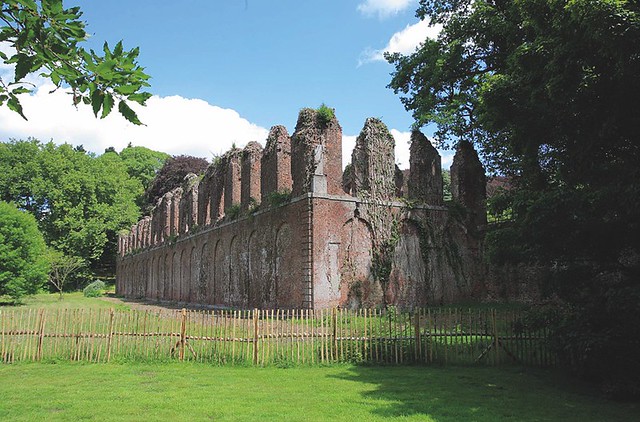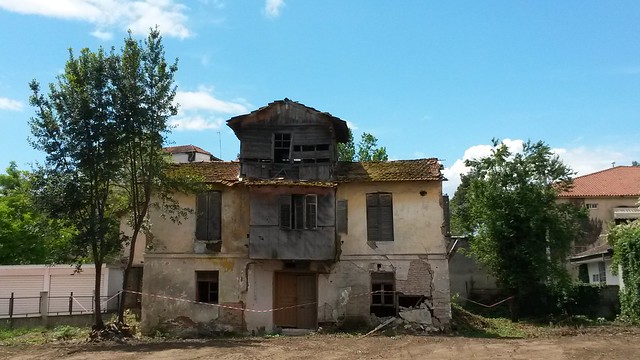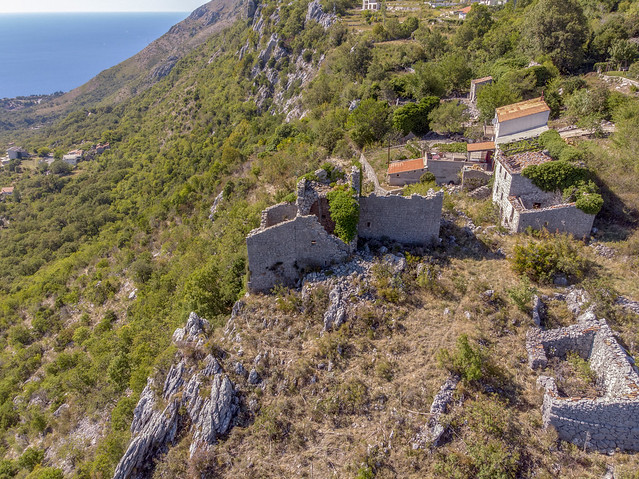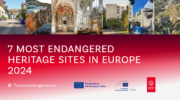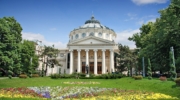11 European heritage sites shortlisted for 7 Most Endangered Programme 2023
Press releases (in 10 languages) and photos can be downloaded at the bottom of this webpage
On the occasion of the 10th anniversary of the 7 Most Endangered Programme in 2023, Europa Nostra – the European Voice of Civil Society Committed to Cultural and Natural Heritage – and the European Investment Bank Institute have just announced the 11 most threatened heritage sites in Europe shortlisted for this year’s edition of the programme.
The 11 most endangered monuments and heritage sites in Europe for 2023 are:
Kortrijk Railway Station, Kortrijk, BELGIUM
Domain and Royal Museum of Mariemont, Morlanwelz, BELGIUM
Partisan Memorial Cemetery, Mostar, BOSNIA AND HERZEGOVINA
Tchakvinji Fortress, Zugdidi, GEORGIA
Sisters’ House Ensemble, former Moravian settlement in Kleinwelka, GERMANY
Mansion (“Konaki”) of Gidas, Alexandreia, GREECE
Herman Ottó Museum, Miskolc, HUNGARY
Memento Park, Budapest, HUNGARY
Cultural Landscape of Paštrovska Gora, MONTENEGRO
Cultural Landscape of Sveti Stefan, Paštrovići, MONTENEGRO
Watermills of Bistrica, Petrovac na Mlavi, SERBIA
(Information about these exceptional but endangered heritage sites and the reasons why they were shortlisted are provided via the links above and later in this webpage)
The Executive President of Europa Nostra, Prof. Dr. Hermann Parzinger, stated: “This shortlist covers a wide variety of monuments and heritage sites which are facing different types of serious threats. The local communities and civil society organisations are deeply committed to preserving these remarkable examples of our shared heritage, but they need broader support. We therefore call on local, regional, national and European stakeholders, both public and private, to join forces with Europa Nostra and our network of members and partners to secure a viable future for these shortlisted sites.”
Prof. Dr. Hermann Parzinger added: “The 7 Most Endangered Programme, which brings together the cultural heritage expertise and advocacy of Europa Nostra and the technical assessment and financial expertise of the European Investment Bank, celebrates its 10th anniversary this year. On behalf of Europa Nostra, I wish to thank the European Investment Bank (EIB) and its Institute as well as all the experts, professionals and volunteers for their significant contribution to saving Europe’s endangered heritage through this meaningful programme”.
The Director of the European Investment Bank Institute, Shiva Dustdar, said: “The EIB Institute is proud to contribute to safeguarding Europe’s endangered heritage through the 7 Most Endangered Programme with our long time partner Europa Nostra. For 10 years now, this catalytic programme has been facilitating the transfer of know-how and experience between different partners and countries. It is innovative in its format, useful in its purpose and shows the cohesive power of cultural heritage which connects European people and communities”.
The selection of the shortlisted sites was made on the basis of the outstanding heritage significance and cultural value of each of the sites as well as on the basis of the serious danger that they are facing today. The level of engagement of local communities and the commitment of public and private stakeholders to saving these sites were considered as crucial added values. Another selection criterion was the potential of these sites to act as a catalyst for sustainable development and as a tool for promoting peace and dialogue within their localities and wider regions.
The 11 endangered heritage sites were shortlisted by an international Advisory Panel, comprising experts in history, archaeology, architecture, conservation, project analysis and finance. Nominations for the 7 Most Endangered Programme 2023 were submitted by member organisations, associate organisations or individual members of Europa Nostra from all over Europe as well as by members of the European Heritage Alliance.
The final list of 7 Most Endangered heritage sites in Europe for 2023 will be unveiled in April.
The 7 Most Endangered Programme, which celebrates its 10th anniversary this year, is run by Europa Nostra in partnership with the European Investment Bank Institute. It also has the support of the Creative Europe programme of the European Union. Launched in 2013, the programme forms part of a civil society campaign to save Europe’s endangered heritage. It raises awareness, prepares independent assessments and proposes recommendations for action. It also provides a grant of €10,000 per listed site to assist in implementing an agreed activity that will contribute to saving the threatened site. In most cases, the listing of an endangered site serves as a catalyst and incentive for the mobilisation of necessary public or private support, including funding.
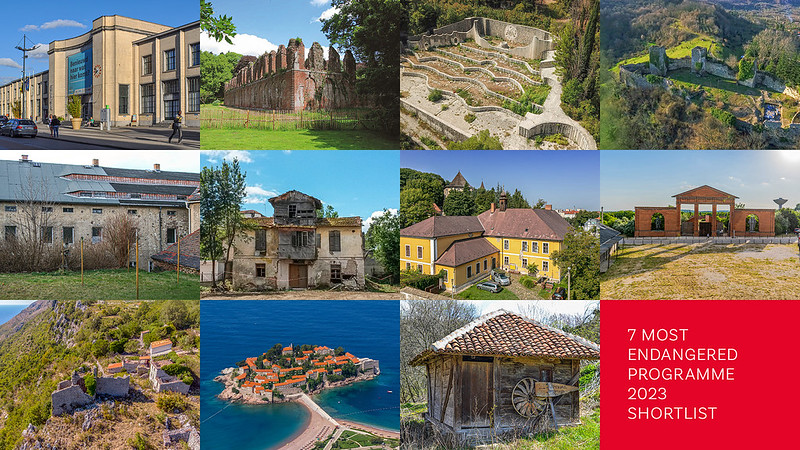
11 European heritage sites shortlisted for
the 7 Most Endangered Programme 2023
(listed in alphabetical order of the country where they are located)
Kortrijk Railway Station, Kortrijk, BELGIUM
The first railway station in Kortrijk was built in 1839, following the European trend of Neoclassicism. It became an important railway junction on the road to France. As a result, it was heavily bombed in 1944. The Kortrijk Railway Station was rebuilt in 1951 to a new design by Pierre Albert Pauwels, one of the most important figures in Belgian contemporary architecture. The rebuilding of the station followed the Expo 58 style, a “discussion” between neoclassical and contemporary elements.
The iconic building is now threatened to be demolished for the development of a new station. The local community has been campaigning against the demolition through petitions.
The Advisory Panel of the 7 Most Endangered Programme stated: “The Kortrijk Railway Station is a unique architectural piece and a well-preserved example of Belgian railway heritage. The recent reconstructions of other Belgian railway stations demonstrate that saving the existing architecture combined with modern additions and functions, go perfectly well together.”
Nominated by the Flemish Association for Industrial Archaeology with the endorsement of Europa Nostra Belgium.
Domain and Royal Museum of Mariemont, Morlanwelz, BELGIUM
Located about 50km south of Brussels, this beautiful 45-hectare domain is an important European ‘lieu de mémoire’ boasting a rich history which dates back to the mid-16th century. Classified as an exceptional heritage site of Wallonia in 2003, Mariemont has two levels of heritage importance: the domain itself, related to the major events, cultural trends and personalities of European history of the last 500 years; and the museum collections of world heritage artefacts, initiated by a visionary philanthropist connected to the European industrial revolution.
At the heart of the domain lie the ruins of a Neoclassical castle built by one of the last governors of the Habsburg Netherlands, atop the foundations of previous princely residencies. The castle was destroyed during the French revolution. Its ruins, which were once part of the park’s open-air museum and backdrop to various archaeological collections, are now in imminent danger of collapse. Close to one third of the Domain around the ruins has been cordoned off for safety and remains inaccessible to researchers and visitors alike.
The Advisory Panel of the Programme “urges the acceleration of administrative and institutional collaboration to focus attention and allocate funding to stabilise the palace ruins and to restore general access to them and their surroundings.”
Nominated by the Royal Museum of Mariemont. With the support of the Wallonia-Brussels Federation, the Walloon Region government and the museum’s vast network of private and academic partners, the museum management considers the preservation of Mariemont as a driver for cultural, economic and social development.
Partisan Memorial Cemetery, Mostar, BOSNIA AND HERZEGOVINA
Built in 1965 in the town of Mostar, the Partisan Memorial Cemetery is one of the largest anti-fascist monuments in the Balkans. It features some 700 individual tombstones as grave markers of freedom fighters from the Yugoslav Partisan movement, being part of a series of monuments and sites built in the region in memory of the partisans who died during World War II. The cemetery was designed by the famous Yugoslav architect Bogdan Bogdanović.
Although much damaged during the war in 1992-1995, the monument suffered further damage in times of peace. After the war, the first conservation and restoration works on the cemetery were done in 2005.
The Partisan Memorial Cemetery has been, and still is, one of the region’s contested heritage sites. This has resulted in repeated acts of vandalism up until June of 2022, which received widespread condemnation.
The Advisory Panel of the 7 Most Endangered Programme commented: “At the time when Europe seeks to assert and put a much stronger emphasis on the vital importance of the shared values which form the very basis of the entire European project, this significant place of memory located in the Western Balkans should be restored with the support of local, national and European funds and protected for present and future generations.”
Nominated by IDEAA Mostar with the endorsement of Mayor of Mostar, Galerija DESSA and Europa Nostra Serbia.
Tchakvinji Fortress, Zugdidi, GEORGIA
The Tchakvinji Fortress, located in the city of Zugdidi, was constructed between the 2nd and 5th centuries and remained in use until the 18th century. This significant monument was a vivid part of the history of Georgia in the region, since it also served as a shelter for the locals during the pre-revolution period of Tsarist Russia. In this period, the fortifications were bombarded with cannons, causing significant destruction.
Abandoned for over two centuries, the monument has suffered from deterioration and has been exposed to severe weather conditions. During the Soviet period, lime mining and the creation of underground vacuums caused the degradation of the slope, affecting the natural landscape as well as endangering the foundations of the monument.
In 2017, the Georgian Government put the Tchakvinji Fortress in the Category of Monuments of National Significance.
The Advisory Panel of the Programme agrees with the nominator that “the proximity to the historic city of Zugdidi and to the Black Sea Coast should be foregrounded as a source of international and local tourism”.
Nominated by the Georgian Arts and Culture Centre (GACC) with the support of the City Hall of Zugdidi Municipality, owner of the site, and other local partners.
Sisters’ House Ensemble, former Moravian settlement in Kleinwelka, GERMANY
Built in the mid-18th century, the Sisters’ House Ensemble (“Schwesternhaus”) is located in Kleinwelka, a former Moravian settlement in Saxony, Germany. The sisters lived together, set up an education system, ensured health care for themselves and locals, and were active in the wider community of Kleinwelka and the rural area beyond.
The Moravian settlement began to decline by the 20th century. Tenants started moving out due to low housing standards. Since then, the abandoned ensemble of buildings has been hardly used and has fallen into decay.
The Advisory Panel of the 7 Most Endangered Programme emphasised: “The Sisters’ House Ensemble has an extraordinary heritage value, though largely unrecognised until recently, but it is also acutely endangered. This ensemble of historic buildings clearly has an architectural value (“modest Baroque style”); furthermore, it embodies immaterial heritage value of past female-based activities within the Moravian but also the wider community, including the local Sorbian minority, as well as cross-border linkages in this German-Czech-Polish border region. Once restored, the ensemble could present local history and serve a variety of social activities of local, regional and cross-border importance.”
Nominated by Europa Nostra Germany with the support of local and international organisations.
Mansion (“Konaki”) of Gidas, Alexandreia, GREECE
The Mansion (“Konaki”) of Gidas, located in the small town of Alexandreia close to Thessaloniki, was probably built in the early 20th century. It is an example of the legacy of the Ottoman Empire in southeastern Europe, uniting the past of several Ottoman and European rural settlements and societies.
However, since the 1970s, the building was mostly left unoccupied and thus it gradually turned into a ruin. During its 40 years of dereliction, there was no protection or any act of conservation of the Mansion of Gidas.
The Advisory Panel of the 7 Most Endangered Programme stated: “The Mansion of Gidas today shows significant damage and deterioration, yet it preserves all its original features and its restoration is still feasible. The typology of the building is important considering that a large number of similar buildings have been destroyed and its location within the urban fabric of the provincial city can make it an important landmark and part of everyday cultural life”.
With the aim of safeguarding the Mansion of Gidas, the local community has joined forces with the Municipality of Alexandreia, the Architecture Department of Aristotle University of Thessaloniki, local experts in fields related to cultural heritage and rural development, and Elliniki Etairia – Society for the Environment and Cultural Heritage. Nominated by a Young Member of Europa Nostra, Mr Yorgos Mertzanides.
Herman Ottó Museum, Miskolc, HUNGARY
The Herman Ottó Museum in Miskolc is a fine example of Renaissance architecture. It housed a Reformed Church School between 1560 and 1902. The building was renovated and enlarged in the 18th century, and was restored at the end of the 19th century, incorporating Neoclassical elements, to accommodate the city’s museum.
In the 1920s, the building was home to the Borsod-Miskolc Museum and functioned as the sole public library of the city. During this period, it became a meeting point for intellectuals and citizens to exchange ideas.
Despite being classified as a Monument of National Importance in 1951-1958 by the Hungarian Government, the building has fallen into decay, and suffers from water ingress, damaged walls, windows and floors.
The local community of Miskolc has campaigned for the restoration of the building to serve both as a museum and a cultural centre. Their efforts have been supported by local and national stakeholders.
The Advisory Panel of the Programme said: “Given its central location and historic significance, if renovated, the Herman Ottó Museum could once again become the cultural centre and play an important role in the intellectual life of Miskolc.”
Nominated by the Scientific Secretary of the Herman Ottó Museum, Dr. Arnold Tóth.
Memento Park, Budapest, HUNGARY
The Memento Park, also known as the ‘Statue Park’, is a history museum, educational centre, artistic action ground and tourist attraction – the resting place of statues which used to symbolise communist ideology in the streets of Budapest between 1945-1989. During the change of the political system in 1989-90, the public in Eastern European communist regimes turned radically against reminders of that era. In Hungary, a unique political and societal compromise initiated the relocation of unwanted public propaganda statues. The design competition to relocate 41 artworks was won by architect Ákos Eleőd. Opened in 1993, Memento Park is Europe’s first, and until today only, propaganda statue collection within a politically neutral setting.
The European significance of Memento Park emphasises the importance of democratic values by presenting political statues within an objective, artistic context; an inspired way to address a challenge faced across Europe.
However, Memento Park’s significance and sustainability are at increasingly urgent risk. Since opening, it has not been subsidised by the State. It has been operated and maintained by a business organisation, with support of a public benefit foundation since 2007. The operators undertake general maintenance, but income is insufficient for expert conservation. The skills needed for appropriate conservation are missing or expensive in Hungary.
Nominated by the Monumentum Public Benefit Foundation and endorsed by ICOMOS Hungary and the Budapest History Museum.
Cultural Landscape of Paštrovska Gora, MONTENEGRO
Paštrovska Gora is located in south-central Montenegro. It consists of many small villages, which feature archaeological remains and historical buildings from many cultures from various phases of history, including the Ilyrian, Medieval, Venetian and Austro-Hungarian periods. The Monastery of Duljevo, dated to the 12th century, the Church of Holy Lady, dated to the 14th century, and the Kosmač Fort, built in the 19th century, are among the most important heritage sites in the area. All these monuments are surrounded by outstanding natural heritage.
Paštrovska Gora was greatly affected by an earthquake in 1979. Since then, many monuments have remained destroyed. Moreover, the cultural and natural landscape of Paštrovska Gora is threatened by potentially damaging developments, namely a plan to install a wind farm of 19 turbines and a plan to build a four-lane motorway, both requiring the successful completion of full environmental impact assessment according to international standards.
The Advisory Panel of the Programme “joins the concerns raised by the local population and local experts, highlighting the need for finding alternative, non-destructive solutions to future development projects, which take in due consideration the values and significance of the rich natural and cultural heritage of Paštrovska Gora.”
Nominated by a group of individuals with the support of NGOs such as Expeditio and Udruženje Paštrovića.
Cultural Landscape of Sveti Stefan, Paštrovići, MONTENEGRO
Sveti Stefan, with Miločer Park, is a cultural heritage site of unprecedented beauty. Sveti Stefan is a 15th-century fortified town, built as the cultural and administrative heart of the Paštrovići region. The 1.2-hectare islet, with its stone houses, four churches, streets, lanes, squares and gardens, is connected by a low bridge to the mainland in close proximity to Miločer Park. The park includes a 1930s summer residence of a Yugoslav royal family, two beautiful beaches, a 19th-century French bridge, and a botanical garden landscaped in the French classical style.
The Advisory Panel of the 7 Most Endangered Programme noted: “Despite Sveti Stefan having National Cultural Heritage Classification (…), the Montenegro state has almost half privatised this national treasure and disenfranchised its own citizens from their own public domain. Unauthorised building and site changes are altering the whole aspect of the site. The public summer theatre has been closed and dismantled. Public access to Sveti Stefan old town and other parts of the site has been forbidden. (…) This is in direct contravention of the Faro Convention which Montenegro ratified in 2008. Furthermore, there is a plan to construct an inappropriate, large-scale condo hotel next to the entrance to Miločer Park, which would cause significant harm to the whole cultural and natural area of Sveti Stefan and Miločer Park, and damage the beauty of the coastline.”
Nominated by the group of citizens “Initiative for Sveti Stefan”.
Watermills of Bistrica, Petrovac na Mlavi, SERBIA
The Watermills of Bistrica are a unique complex of mills for grinding grain and rolling cloth, created between the 19th century and the mid-20th century, in the village of Bistrica in Eastern Serbia. The architecture of the watermills presents the folk characteristics of Balkan rural structures, namely small-scale and wooden constructions.
Today, the watermills are under the threat of destruction due to their long-term abandonment and exposure to harsh weather conditions.
The Advisory Panel of the 7 Most Endangered Programme said: “Together with other residential, spiritual and commercial buildings of vernacular architecture, the Watermills of Bistrica form a unique rural landscape, bearing witness to the important process of food production once present throughout Europe. (…) With proper restoration, interpretation and a sustainable cultural tourism plan, the Watermills of Bistrica could become a great example of successful heritage revitalisation bringing multiple benefits to local community and economy.”
Nominated by the local community – with the support of the local “Native Museum” and the Assembly of Millers of the Region, and in collaboration with the Tourism Organisation of the Municipality of Petrovac na Mlavi – and with the endorsement of Europa Nostra Serbia.
FIND OUT MORE
Press releases All sites – English │ Kortrijk Railway Station – Dutch & French │ Mariemont – French │Partisan Memorial Cemetery – Bosnian │ Tchakvinji Fortress – Georgian │ Sisters’ House Ensemble – German │ Mansion of Gidas – Greek │ Herman Ottó Museum – Hungarian │ Memento Park – Hungarian │ Paštrovska Gora – Montenegrin │ Sveti Stefan – Montenegrin │ Watermills of Bistrica – Serbian
Photos & e-banners │ Video
www.7mostendangered.eu
http://institute.eib.org
Europa Nostra
Joana Pinheiro, Communications Coordinator
jp@europanostra.org
M. +31 6 34 36 59 85
Europa Nostra
Antigoni Michael, 7 Most Endangered Programme Coordinator
am@europanostra.org
T. +31 (0) 70 302 40 51
European Investment Bank Institute
Bruno Rossignol
bruno.rossignol@eib.org
T. +352 43 797 07 67; M. +352 621345 862

